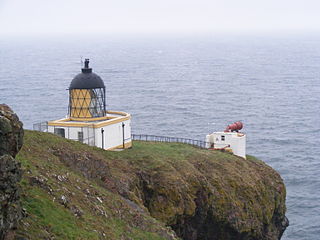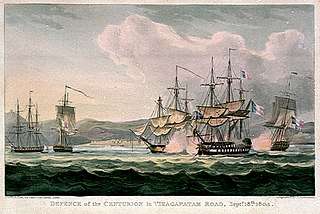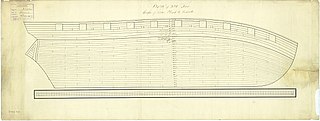Since the 1760s, there have been numerous vessels named Royal Charlotte, for Charlotte of Mecklenburg-Strelitz, consort of King George III.

Charlotte of Mecklenburg-Strelitz was the wife of King George III. She served as Queen of Great Britain and Queen of Ireland from her wedding in 1761 until the union of the two kingdoms in 1801, after which she was Queen of the United Kingdom of Great Britain and Ireland until her death in 1818. She was also the Electress of Hanover in the Holy Roman Empire until the promotion of her husband to King of Hanover on 12 October 1814, after which she was also queen consort of Hanover.

George III was King of Great Britain and King of Ireland from 25 October 1760 until the union of the two countries on 1 January 1801, after which he was King of the United Kingdom of Great Britain and Ireland until his death in 1820. He was concurrently Duke and prince-elector of Brunswick-Lüneburg ("Hanover") in the Holy Roman Empire before becoming King of Hanover on 12 October 1814. He was the third British monarch of the House of Hanover, but unlike his two predecessors, he was born in Great Britain, spoke English as his first language, and never visited Hanover.
Contents
- Muster rolls exist for a number of vessels that participated in the Atlantic slave trade. [1] The vessels sailed from Bristol to West Africa (primarily to the Bights of Benin and Bonny), where they picked up slaves for sale in the Caribbean. The rolls exist for 1763, 1767, 1783 to 1789, and 1793. The slaves were delivered to Antigua, Grenada (417 slaves delivered), Jamaica (377 slaves delivered), St Vincent (420 slaves delivered), and Tobago (450-60 slaves purchased). One vessel sailed to West Africa for hardwoods and then returned directly to Bristol. In 1793 the French captured a Royal Charlotte while she was on her way to West Africa, war with Britain having broken out.
- Between 1793 and 1810, six apparently different vessels named Royal Charlotte received letters of marque. The four that did not belong to the Excise and Customs service were: [2]

The Atlantic slave trade or transatlantic slave trade involved the transportation by slave traders of enslaved African people, mainly to the Americas. The slave trade regularly used the triangular trade route and its Middle Passage, and existed from the 16th to the 19th centuries. The vast majority of those who were enslaved and transported in the transatlantic slave trade were people from central and western Africa, who had been sold by other West Africans to Western European slave traders, who brought them to the Americas. The South Atlantic and Caribbean economies especially were dependent on the supply of secure labour for the production of commodity crops, making goods and clothing to sell in Europe. This was crucial to those western European countries which, in the late 17th and 18th centuries, were vying with each other to create overseas empires.

Bristol is a city and county in South West England with a population of 459,300. The wider district has the 10th-largest population in England. The urban area population of 724,000 is the 8th-largest in the UK. The city borders North Somerset and South Gloucestershire, with the cities of Bath and Gloucester to the south-east and north-east, respectively. South Wales lies across the Severn estuary.

Antigua, also known as Waladli or Wadadli by the native population, is an island in the West Indies. It is one of the Leeward Islands in the Caribbean region and the main island of the country of Antigua and Barbuda. Antigua and Barbuda became an independent state within the Commonwealth of Nations on 1 November 1981.
- Royal Charlotte (1774 ship), launched at Bombay in 1774 and destroyed in an explosion in 1797.
- Ship of 342 tons (bm), Captain Thomas Bruce, 23 men, 16 x 12-pounder and 6 x 4-pounder guns (LoM dated 13 February 1801)
- Brig of 261 tons (bm), Captain Alexander Morris, 30 men, 16 x 6 & 8-pounder guns (LoM dated 15 September 1807)
- Cutter of 137 tons (bm), Captain Thomas Robertson, 40 men, 2 x 4-pounder and 8 x 9-pounder guns + four swivels (LoM dated 20 May 1808)
Royal Charlotte was launched by Bombay Dockyard in 1774 as a country ship. She made one voyage for the British East India Company in 1796 when she sailed from Calcutta to Britain. There she took on British registry. She sailed back to Calcutta where a lightning bolt ignited her magazine, destroying her in 1797.
Builder's Old Measurement is the method used in England from approximately 1650 to 1849 for calculating the cargo capacity of a ship. It is a volumetric measurement of cubic capacity. It estimated the tonnage of a ship based on length and maximum beam. It is expressed in "tons burden", and abbreviated "tons bm".
- Royal Charlotte, of the Excise for Scotland, in 1799 was responsible for patrolling from St Abb's Head to Caithness. She was of 227 tons (bm) and carried 18 guns. She had a crew of 60 men under the command of Charles Elder. [3]

St Abb's Head is a rocky promontory by the village of St Abbs in Berwickshire, Scotland, and a national nature reserve administered by the National Trust of Scotland.

Caithness is a historic county, registration county and lieutenancy area of Scotland.
- Royal Charlotte (1819 ship) carried convicts from Britain to Australia. She wrecked in 1825.
Royal Charlotte was a three-masted merchant ship launched in 1819. Royal Charlotte carried convicts to Australia in 1825. On her way home to India via Batavia she wrecked on 11 June, but with minimal loss of life.
A convict is "a person found guilty of a crime and sentenced by a court" or "a person serving a sentence in prison". Convicts are often also known as "prisoners" or "inmates" or by the slang term "con", while a common label for former convicts, especially those recently released from prison, is "ex-con" ("ex-convict"). Persons convicted and sentenced to non-custodial sentences tend not to be described as "convicts".

